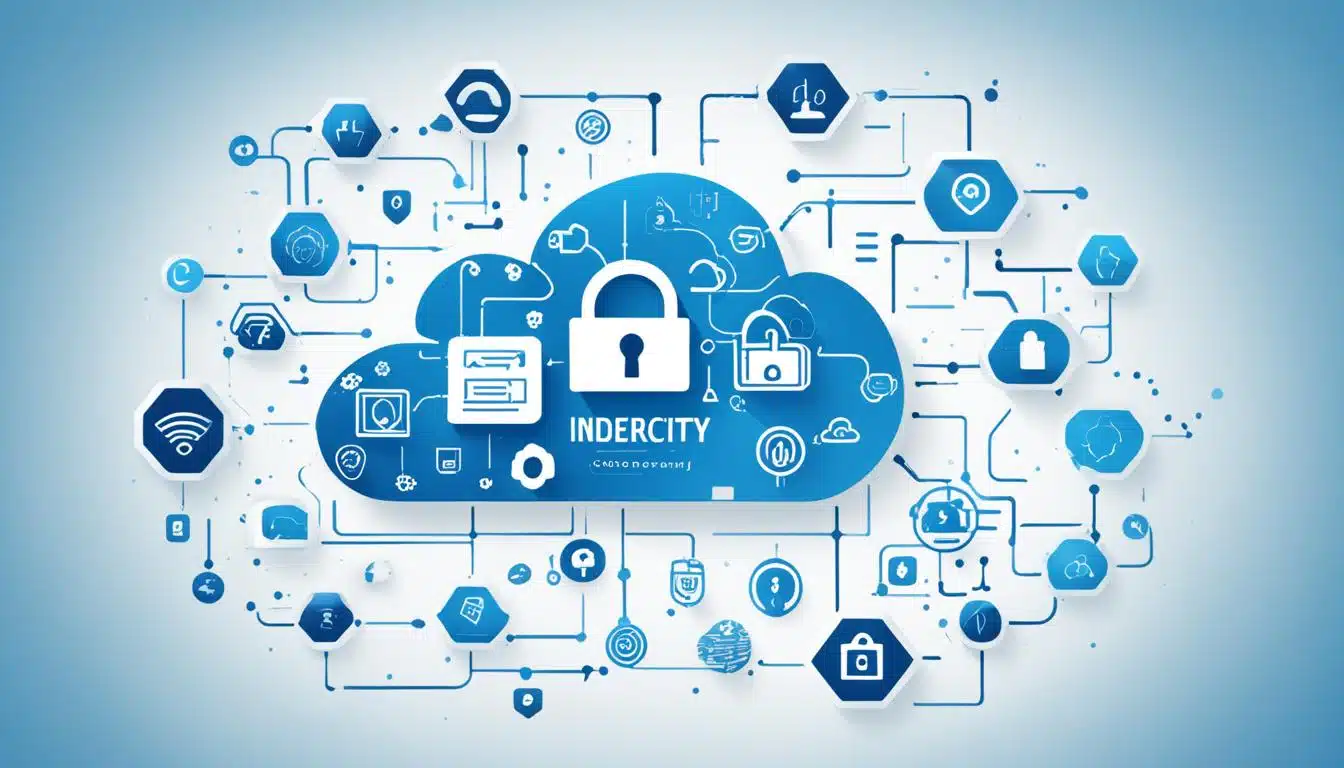In today’s age, future of cloud computing work is a big deal. Companies are moving to the cloud to gain flexibility, scalability, and save money. With this move, the importance of proper identity and access management (IAM) has grown hugely. Now, businesses can access amount of computing services anytime they need through the internet. This new way of working has truly changed the game for many.
Moving to the cloud brings new security challenges. Hackers look for different ways to deploy cloud to get into systems using weak or stolen passwords. Shockingly, 63% of data breaches happen this way. Cybersecurity pros say a system is only as safe as its weakest part. This is where cloud IAM steps in, helping to control who can access important data in the cloud.
Cloud IAM is all about the tools and rules that protect a company’s data managed by the cloud. It decides who gets to see what and when. This keeps permissions current and helps companies notice if someone’s trying to get in illegally. With more and more organizations using the cloud, how we manage who can see what is super important for keeping things safe.
Key Takeaways
- Cloud computing has transformed the way businesses operate and manage their data, leading to the need for robust identity and access management (IAM) solutions.
- Cloud IAM encompasses the tools, policies, and processes that protect an organization’s sensitive data and resources in the cloud.
- Cloud IAM plays a crucial role in mitigating security threats by controlling access to critical resources across cloud platforms.
- As organizations adopt various cloud deployment models, the importance of cloud IAM in enterprise security has become increasingly critical.
- Effective cloud IAM can enhance security, enable global access and mobility, provide cost savings, and streamline compliance for organizations.
What Is Cloud Identity and Access Management (IAM)?
Cloud IAM is a set of tools and rules that keep important data safe in the cloud. It controls who can see or use the data and when they are allowed to. This way, it makes sure only the right people access what they should.
Definition and Overview of Cloud IAM
Cloud IAM is like a big system that looks after who can do what online. Companies use it to give responsibilities to different groups of users. For example, people who need to check on the system but don’t need to change anything. They also use it to quickly update who can access what, as roles change.
Watching how people access the system helps in spotting odd logins. This boosts the security of everything stored in the cloud providers host and manage.
Key Components of Cloud IAM
Cloud IAM has three big parts: identity, access, and policies. Identity is about creating user accounts and managing groups. Access decides who or what can use certain resources. Policies set the rules for all of this, making sure everyone gets the right access.
Differences Between Traditional IAM and Cloud IAM

In the past, many companies handled their data and software in their own buildings. They used physical tools and hands-on permission controls. This way of identity management, called traditional IAM, often led to mistakes. This was because people had to manually manage who could access what.
When work started to move to the cloud computing resources, these methods weren’t good enough. New ways into the systems meant more chances for bad actors to attack.
On the other hand, cloud refers IAM brings a lot of good things compared to the old traditional setups. It uses advanced security, is very flexible, and can grow with a business’s needs very easily. All this thanks to the power of use cloud computing.
Unlike before, workers can easily and safely use their tools from wherever they are. And a lot of the boring identity management tasks are done by machines. This means less chance for errors and quicker meeting of rules.
| Feature | Traditional IAM | Cloud IAM |
|---|---|---|
| Security | Relies on physical security measures and manual permission management, which can be vulnerable to human errors and cyber threats. | Leverages cloud-native security controls, multi-factor authentication, and automated monitoring to mitigate security risks. |
| Flexibility | Limited to the on-premises infrastructure, requiring manual adjustments to accommodate changes in the IT environment. | Offers greater flexibility and scalability to adapt to dynamic business needs and evolving cloud infrastructure. |
| Scalability | Scaling up or down can be complex and time-consuming, as it involves procuring and configuring additional physical hardware. | Allows for seamless scalability by leveraging the one cloud computing provides infrastructure and resources, enabling organizations to easily adjust their identity management capabilities as needed. |
| Global Access | Restricts user access to the physical location of the on-premises infrastructure. | Enables global access and mobility, allowing employees to securely access applications and resources from anywhere. |
| Automation | Requires manual processes for user provisioning, role changes, and access control management. | Offers automated identity management tasks, such as onboarding, offboarding, and access control, reducing the risk of human error and streamlining compliance. |
As more and more businesses move to the cloud, they find cloud IAM to be essential. Cloud IAM solves many of the problems of traditional methods. It offers better security, more flexibility, easier growth, and less manual work. This makes it a key part of keeping a company’s systems safe today.
Benefits of Cloud IAM

Moving to cloud identity and access management (cloud IAM) has major perks. It boosts security, offers access from anywhere, and cuts costs. Cloud IAM is a helpful tool that simplifies handling user identities. It also checks off the box for following rules.
Enhanced Security
Cloud IAM security is better than old-school systems. It looks at who’s getting in and stops threats from the inside. This means it helps stop problems that come from secrets being shared or when people get into things they shouldn’t.
Global Access and Mobility
Cloud IAM shines when it comes to people working from anywhere. It lets staff reach their work stuff no matter where they are or what gadget they’re using. This keeps things moving along and makes teamwork easy, no matter the distance.
Cost Savings
Switching to cloud IAM can really save you money. You won’t need to buy as much tech or software because it’s all in the cloud. Plus, you only pay for what you use. This makes managing your IT budget a lot simpler.
Automation and Streamlining
Making things go faster and smoother is what cloud IAM automation is all about. It sets up and takes away user access without anyone having to do it by hand. This keeps the door closed to bad actors and keeps everyone playing by the rules.
Regulatory Compliance
Staying on the right side of the law is a must for most big companies. Cloud IAM has your back by doing a lot of the work needed to prove you’re following the rules. It keeps an eye on things, checks up on who’s doing what, and can even create reports. This helps your company show it’s respecting privacy and security laws.
Cloud IAM Challenges

Switching to a cloud-based identity and access management (IAM) can be tough for groups. The first challenge many face is the initial configuration and setup when adding their whole team.
Initial Configuration and Setup
Getting started with cloud IAM means creating groups, roles, and access rights for users. This part can take a lot of time and effort. You have to examine your current IT set-up and work processes closely. Adding new rules can sometimes go wrong, causing the system to not work right. This can open the door to possible security issues.
Identity and Configuration Management
Keeping up cloud IAM’s effectiveness needs constant effort. When people join, leave, or switch jobs, their digital access must change too. If you don’t make these updates correctly, it can create security problems.
Integration with Existing Systems
Making a cloud IAM work with existing on-premises systems and applications is hard. It takes careful effort to sync data and user details correctly. If this is not done well, it can slow down work, add more complexity, and cause security risks.
How Cloud Computing work?
Cloud computing is the delivery of computing services, such as servers and storage, over the internet. This method has changed how people and companies get and use computing power. It makes technology more flexible, scalable, and affordable for various needs.
Overview of Cloud Computing Services
There are three types of cloud services: IaaS, PaaS, and SaaS. IaaS gives you access to digital resources like servers. PaaS is a space for making and using applications. SaaS lets you use software on the internet instead of installing it directly.
Cloud Deployment Models
Cloud services adapt to organizations in three main ways: public, private, and hybrid. Public cloud services are available to many people through third parties. Private cloud is just for one organisation, giving them more control. Hybrid clouds mix public cloud and private benefits, helping companies use their resources better.
| Cloud Service Model | Description |
|---|---|
| Infrastructure as a Service (IaaS) | Provides access to virtual computing resources, such as servers, storage, and networking, allowing users to build and manage their own digital infrastructure. |
| Platform as a Service (PaaS) | Offers a platform for developing, testing, and deploying applications, providing the necessary tools and infrastructure without the need for on-premises installation and maintenance. |
| Software as a Service (SaaS) | Delivers software applications over the internet, eliminating the need for on-premises installation and maintenance, and providing access to the software from any device with an internet connection. |
| Public Cloud | Cloud services provided by third-party cloud service providers and accessible to the general public, offering a cost-effective and scalable solution. |
| Private Cloud | Cloud infrastructure owned and managed by a single organization, providing greater control and customization over the computing resources. |
| Hybrid Cloud | A combination of public and private cloud, allowing organizations to leverage the strengths of each model and optimize their computing resources. |
Cloud IAM Best Practices

Moving operations to the cloud means taking extra care with data security and rules. Cloud Identity and Access Management (IAM) must be strong. Here’s what to do:
Implement Multi-Factor Authentication
Make sure users cannot get into the cloud model with just a username and password. Use something like multi-factor authentication. It needs a trusted device as well. This makes it tough for the bad guys and keeps your data safe.
Follow Principle of Least Privilege
Give each user only the permissions they need. This is the principle of least privilege. It stops big trouble if something goes wrong. Because users can only do what they really need to do.
Enable Continuous Monitoring
Always watch what’s happening with your cloud IAM. Good logging, audits, and watching how users act are key. They spot any weird behavior fast, helping you stop attacks quickly.
Federate with Identity Providers
Work your cloud IAM with systems you already use, like Active Directory. It makes managing users easier and keeps your access rules the same. Plus, it makes logging in easier for users, thanks to SSO.
By following these best practices for cloud IAM, companies can make their digital spaces more secure. They help handle who gets into what, making sure rules are followed. This meets laws and internal rules better, too.
Choosing the Right Cloud IAM Solution

Organizations need to look at their cloud IAM solution carefully. They should match it with their tech stack and workflows. This will ensure the new system works well with the old ones.
This process includes looking at how staff use different apps and services. They need to know when and what parts they access. Cloud computing eliminates the capital investment in physical infrastructure, allowing businesses to scale resources according to their needs and pay only for what they use.
Assess Current Tech Stack and Workflows
It’s key to map out how your IT is set up. This ensures your workflows are replicable. Also, it keeps data in sync for employees.
By knowing the current tech and ways of working, choices about the cloud IAM features get easier. You can pick ones that match your business needs well.
Evaluate Security and Compliance Needs
Looking at the technical needs is not enough. Organizations need to think about security and compliance. They should check if the IAM solution is safe. It must also meet the rules and work well with other security tools.
| Considerations for Choosing a Cloud IAM Solution | Key Factors |
|---|---|
| Assess Current Tech Stack and Workflows |
|
| Evaluate Security and Compliance Needs |
|
With a deep look at current workflows , security needs, and compliance needs, decisions become clear. This helps in choosing the right cloud IAM solution for meeting your goals.
Role of Cloud IAM in Enterprise Security

Cloud IAM (Identity and Access Management) is vital for boosting enterprise cybersecurity. It fights off cyber threats by keeping a close eye on who’s accessing what on the cloud adoption. This way, it cuts down on the risk of insider attacks. It does this by smoothly handling job changes and joining or leaving the company.
It also uses the power of AI to watch over things. This helps stop bad actors trying to sneak in or do harm by spotting odd logins fast.
Mitigating Cyber Threats
Keeping businesses safe in the digital world, cloud IAM is key. It makes sure only the right people and devices can get to the important stuff. This shrinks the area that attackers can aim for.
It also keeps tabs on what users do and how they act. This helps security teams find and stop trouble before it blows up into a big crisis.
Controlling Access to Cloud Resources
Managing who gets into cloud resources is a big part of security for companies. Cloud IAM leads this charge. It sets detailed rules and roles so that users only get the access they really need. Setting things up like this not only makes things safer but also helps meet rules and codes.
Then, there are tools like visibility and user behavior analytics. These help security teams spot problems early. This keeps private data and resources safe and sound in the cloud migration.
Also Read :
FAQs
Q: What is Identity and Access Management in the context of Cloud Computing?
A: Identity and Access Management (IAM) in cloud computing is the process of managing and controlling access to resources and applications hosted in the cloud. It involves defining and enforcing policies to ensure the right users have the appropriate access privileges.
Q: What are the benefits of implementing Identity and Access Management in Cloud Computing?
A: Some benefits of IAM in cloud computing include improved security, enhanced compliance, simplified user management, centralized access control, and increased operational efficiency.
Q: How does IAM work in different types of cloud computing environments?
A: IAM works by authenticating users, authorizing access based on defined policies, and monitoring activities to ensure security in main types of cloud computing such as public cloud, private cloud, and hybrid cloud.
Q: What are the main types of cloud services related to Identity and Access Management?
A: Three main types of cloud services related to IAM are Infrastructure as a Service (IaaS), Platform as a Service (PaaS), and Software as a Service (SaaS), each offering different levels of control and management options for IAM. Our computing services include the ability to seamlessly integrate cloud-based solutions into your existing infrastructure.
Q: How does cloud security play a role in Identity and Access Management?
A: Cloud security is crucial for IAM as it ensures that access controls, encryption, authentication mechanisms, and other security measures are in place to protect sensitive data and prevent unauthorized access and learn more about cloud computing environments.
Q: What is the future outlook for Identity and Access Management in Cloud Computing?
A: The future of IAM in cloud computing is likely to involve more advanced technologies like machine learning, biometrics, and adaptive access controls to enhance security and provide more seamless user experiences. The company invested in vast amounts of computing resources to handle the increasing demands of data processing.
Q: Who are some major cloud computing service providers offering Identity and Access Management solutions?
A: Leading cloud service providers like Amazon Web Services (AWS), Microsoft Azure, Google Cloud Platform, and IBM Cloud offer robust IAM solutions as part of their cloud offerings to help organizations secure their cloud environments. Private cloud refers to cloud computing resources that are dedicated solely to one organization, providing enhanced security and control over data and applications.
Source Links
- https://www.geeksforgeeks.org/identity-and-access-management/
- https://cloud.google.com/security/products/iam
- https://www.strongdm.com/blog/cloud-identity-access-management
Conclusion
Cloud identity and access management (IAM) offers tools and practices to safeguard vital resources. These resources are spread across cloud services and platforms. It brings better security, a global reach, saves money, and simplifies compliance.
Setting up cloud IAM can be tricky at first. This includes configuring, managing identities, and linking with current systems. Despite these hurdles, the benefits over time are huge. It’s a smart move for companies looking to secure their cloud spaces.
Best practices include using multi-factor authentication and giving the least amount of privilege needed. Also, keeping an eye on security all the time and working closely with identity providers help fight off attacks. They ensure access to cloud resources stays under control.
The importance of cloud IAM in keeping businesses safe is growing. Picking the right cloud IAM system is key. It should match a company’s tech, workflow, and security needs well. This way, organizations can enjoy the perks of cloud tech while keeping their data and systems safe from harm.





